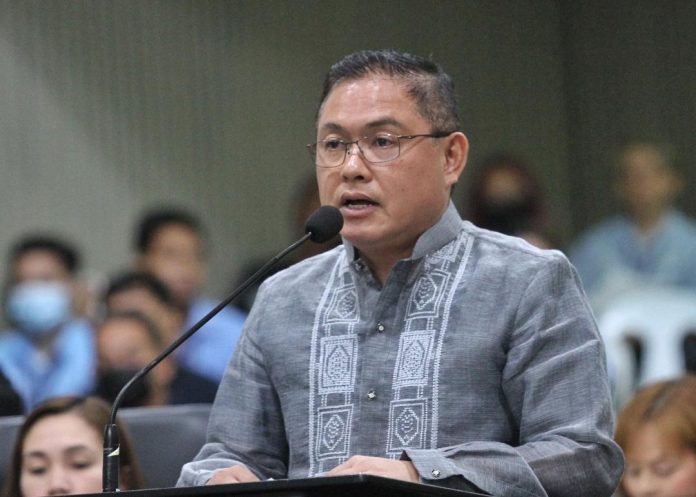
Councilor Temujin “Tek” Ocampo, chairperson of the Committee of Environment, urged environmental groups, Sustainable Davao Movement (SDM) and Ecoteneo of the Ateneo de Davao University, to file a Writ of Kalikasan before the Supreme Court (SC) if they perceived that the construction of the 4.07-kilometer Samal Island – Davao City Connector (SIDC) Project will cause destruction to the environment.
The said environmental groups have raised concerns about the impact of the construction on the environment particularly the corals in the Paradise Reef.
“Nasabtan pud nato ang concerns sa other sectors but then again we need to follow what is the process kay kung gusto nato na ipahunong, they should file the Writ of Kalikasan in the court because that is the proper venue and the city council cannot decide on matters like that,” Ocampo said during the Aprubado sa Konseho media briefing on Tuesday.
Ocampo said during the deliberation in the committee hearing, Bagani Evasco, former regional director of the Department of Environment and Natural Resources 11 (DENR 11) showed a video of the corals in the Paradise Reef and assured him that there is a way to relocate them, if not relocate if the corals will be damaged, they can be rehabilitated.
“Naa man gud sila gihimo sa Mabini nga nag repopulate sila sa corals by putting artificial reefs and they were able to rebuild it in around eight months. Kay mao tu akong concerns kung simbako naay madaut dinha unsa man ang pasalig sa DENR mahitungod niana ug sulti nila ila gyud daw i-rehabilitate,” Ocampo said.
Ocampo said that the groups also raised concerns that the construction would disturb the marine life.
“Ang Department of Public Works and Highways (DPWH) nag-explain during the committee hearing ug gi-demonstrate nila ang technology nga ibutang nila tung mura ug tubo sa dagat and then vibration lang hinayhinay ug lubong and kuhaon tung balas na makuha didto and then i-recycle ang balas ug sagulan nila ug semento ug mao tu ilang gamiton as poste sa tulay,” he explained.
Ocampo said the DPWH assured that no sand would be wasted during the dredging.
He said that DENR also assured that the equipment that they will be using will not have a great impact on the marine life.
Engr. Joweto Tulaylay, Project Manager of the SIDC Project, stated the proposed mitigating measures will be observed according to the Environmental Impact Assessment (EIA) conducted by the DPWH, and a Multipartite Monitoring Team (MMT) will monitor any damage caused during construction and respond with appropriate mitigating or rehabilitating measures.
“Sa pangutana kung puwede ba masibog ang tulay as requested by opposing parties, maglisod daw sila ana kay the tulay itself is already mao nato ang pinaka the best alignment,” Ocampo said.
Ocampo was referring to the request of Ecoteneo and SDM to share their studies which may allow a window to revisit the landing site options that may directly affect the Paradise Reef and the SIDC project design to meet economic gains with ecological sustainability.
“Ang cost man gud daw kung magbalhin ka ug tulay is around P2 billion per kilometer. Dili na pud daw na puwede ibalhin kay according to them (DPWH) mao na gyud tu ang the best area,” he said.
Ocampo said that on the Davao City side, there are only artificial corals established by the Bureau of Fisheries and Aquatic Resources (BFAR).
“Ang pangutana nako sa BFAR ug DENR unsa ang effect as far as the environment is concern, can be manage man daw ug mao gihapon kung naay maapektuhan they can rehabilitate,” Ocampo said.
Based on the summary of the consolidated committee report and after verification, it was found out that the issues and concerns raised regarding the impact of the project on coral reefs and the local ecosystem, the issuance of SP Resolution prior the grant of Environmental Compliance Certificate (ECC), traffic congestion, realignment of the SIDC Bridge, issues concerning Marine Protected Areas (MPA), the impact on nearby businesses and individuals, have been clarified and addressed based on the above discussions, and the documents submitted by the concerned government agencies confirm full compliance before the commencement of the construction of the SIDC Connector Project.
“Moreover, the primary environmental concern about the destruction of the coral reefs on Samal Island, as raised by concerned individuals, was outside the jurisdiction of the city government of Davao. Given that the SIDC is a national infrastructure project involving two localities Davao City and Samal, and crossing territorial boundaries, any specific environmental concerns should be escalated to the appropriate government agencies such as DENR at the regional and national level, or to the proper court if necessary,” it said.
The SIDC Project is a 4-lane extra dosed bridge with a 530-meter main bridge; a land viaduct of 570-meter on the Davao City side and 395-meter on the Samal Island side; and western and eastern marine viaducts of 350-meter and 510-meter, respectively. It has ramps tapping into the R. Castillo-Daang Maharlika junction, Davao City, and a 24-meter wide at-grade road and roundabout at Brgy. Limao along Samal Circumferential Road, IGaCoS.






